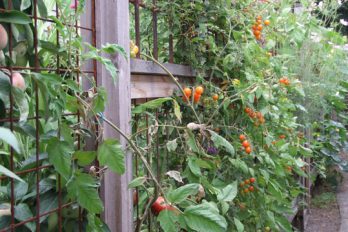Surprisingly, I only discovered balloon flowers about 30 years ago when my family moved to our present house where I saw them combined with double Shasta daisies.
Platycodon is a monotypic genus (having only one species) native to the Far East. These easy-to-grow perennials are members of the Campanulaceae, or bellflower, family. Dwarf plants are excellent for adding colour to the summer rock garden. I like to combine them with short blue fescue grasses (Festuca glauca) and the smaller forms of yellow Allium flavum. Balloon flowers also look good in a cottage garden and give an old-fashioned touch to a mixed perennial border. P. grandiflorus roseus is a pink cultivar that I’ve combined with a pink rose and a pink Clematis integrifolia. Felt-like grey lambs ears (Stachys byzantina) covered the ground below these plants, until they were shaded out by other plants.
Balloon flowers grow in neat clumps, up to 60 centimetres (24 inches) high with alternate oval leaves about five centimetres (two inches) long. Sometimes the leaves have a silvery blue sheen. The terminal flowers develop as fat inflated buds, or balloons. My children tried to pop them by pinching them with their fingers! In August and September, the flowers open into saucer-shaped, outward-facing five-pointed stars which are about four to five centimetres (about two inches) across. Blue is the most common colour, ranging from pale to mid-blue. A slightly darker cultivar, P. grandiflorus ‘Hakone Blue’, has semi-double flowers that feature two layers of petals. P.g. Mother-of-Pearl ‘Perlmutterschale’ and others such as P.g. roseus are pink. Several cultivars are white, including P. ‘Fuji White’. Double balloon flowers are really semidoubles with two whorls of petals. (The stamens of true doubles are reduced in size, or replaced by petals.)
P.g. Apoyama Group, one of several dwarf types, grows about 20 centimetres (eight inches) high. Despite their short stature dwarf specimens bear full-sized flowers.
Platycodon ‘Sentimental Blue’ is a 15-centimetre (six-inch) F1 hybrid form that blooms four months from sowing seed and continues all summer long. It can be used in pots or for bedding out in the garden.
Balloon flowers are hardy to Zone 4 and grow well in any good, moist well-drained soil. Although they prefer full sun, they will also grow in partial shade. They dislike being moved as they have long taproots and smaller secondary roots, which can be damaged when dug up. Because they emerge late in the spring, it’s a good idea to mark the spot so you don’t plant over them.
Balloon flowers can easily be propagated from seed. Start them indoors in January or February, sowing seed in pots of sterile soilless mix such as Promix. Or sow seed in pots outdoors over the winter. They should germinate in the spring once temperatures reach 21°C (70˚F). If you have a particularly good form of balloon flower that you want to propagate, sometimes they can be successfully rooted from side shoots removed from the plant when they emerge in the early spring.




